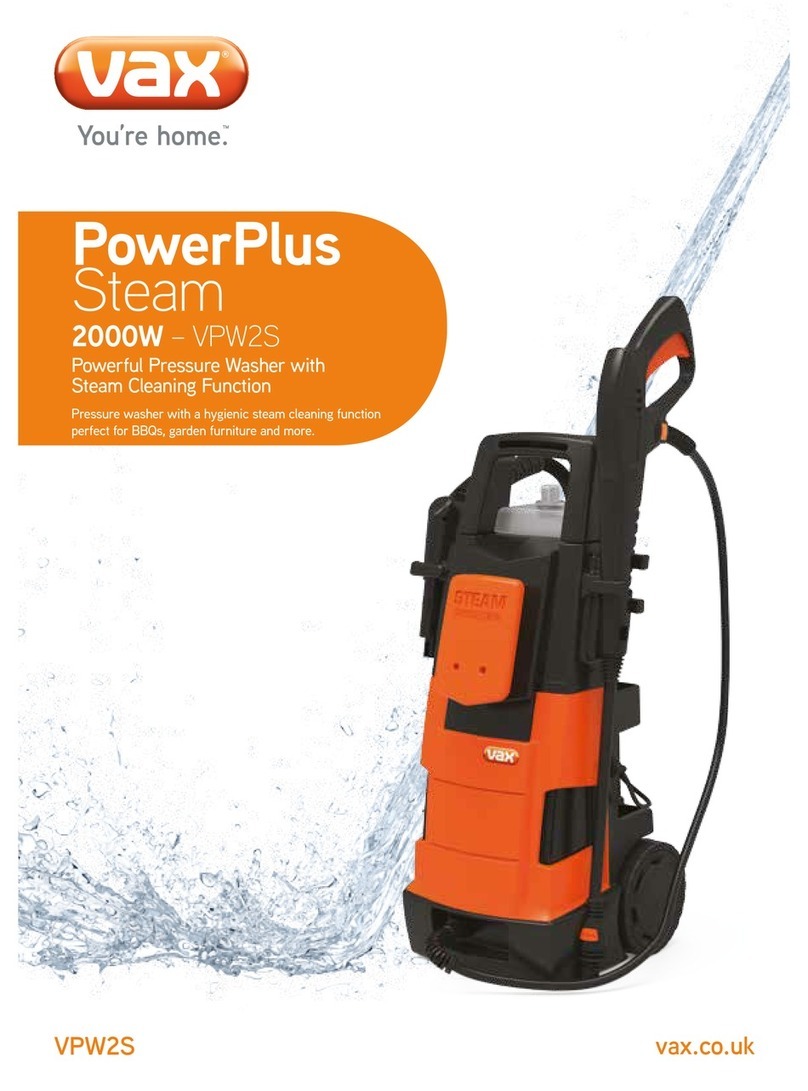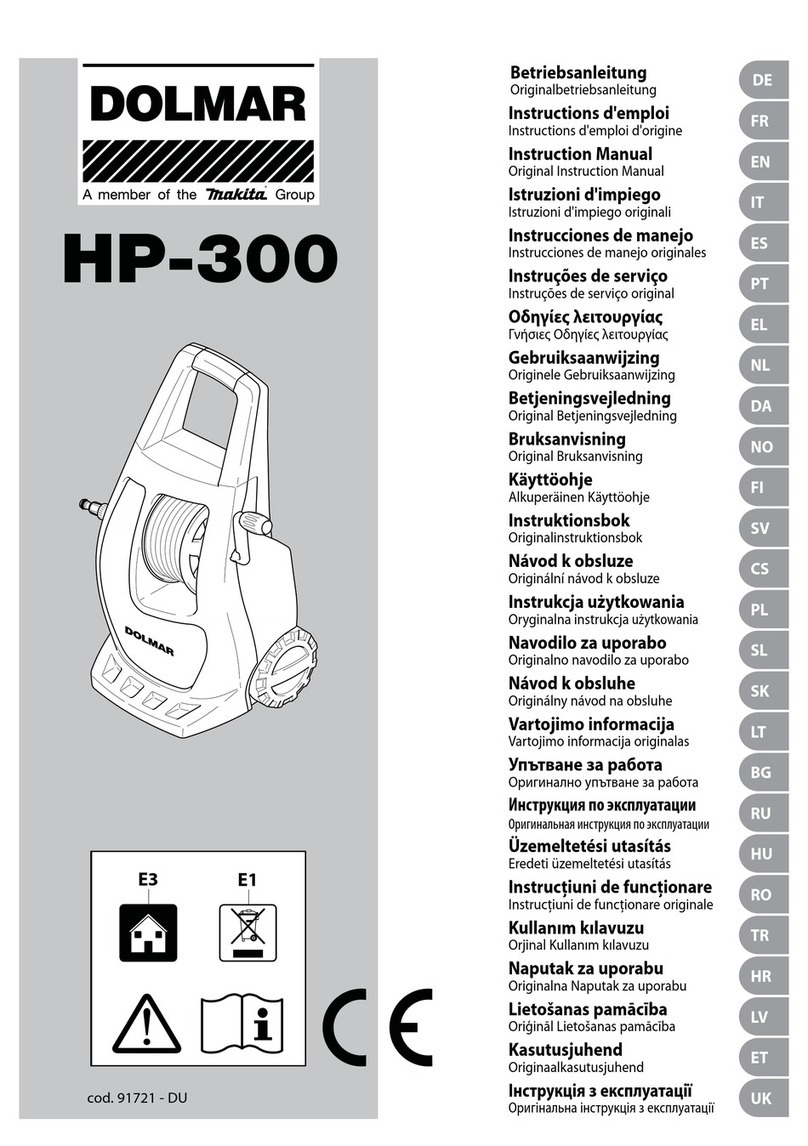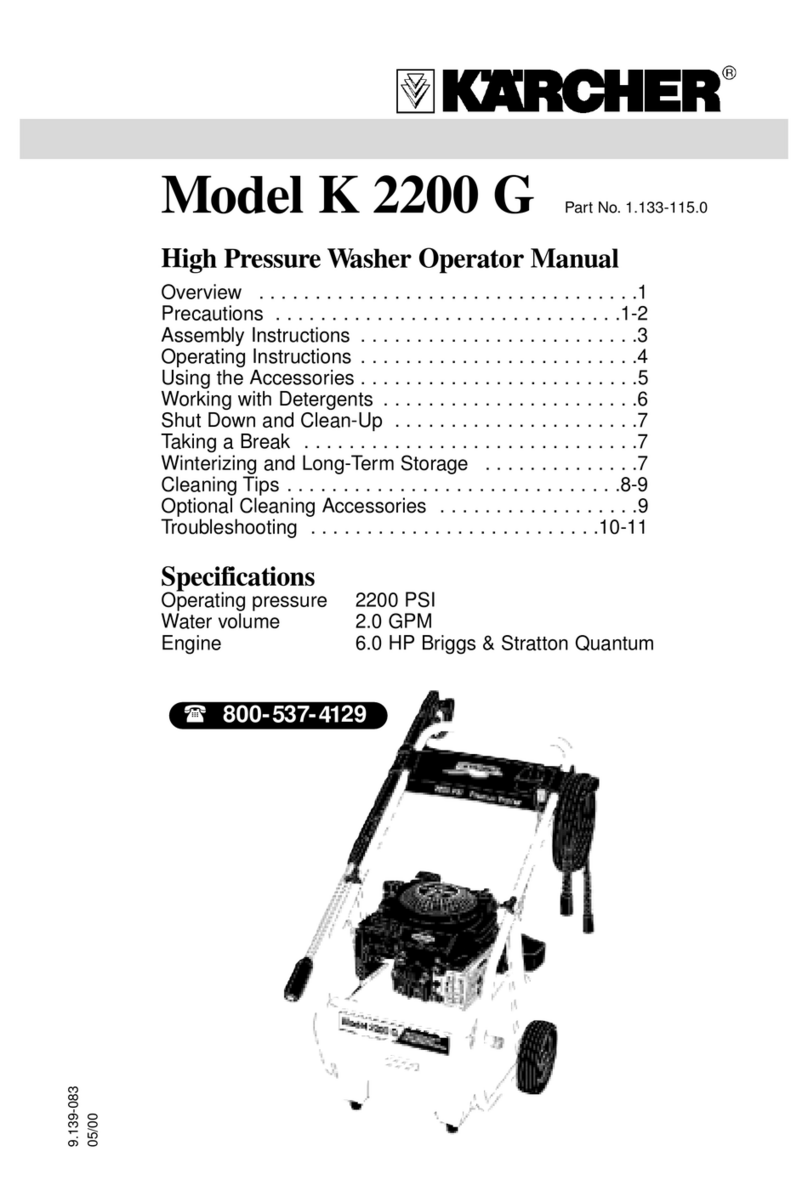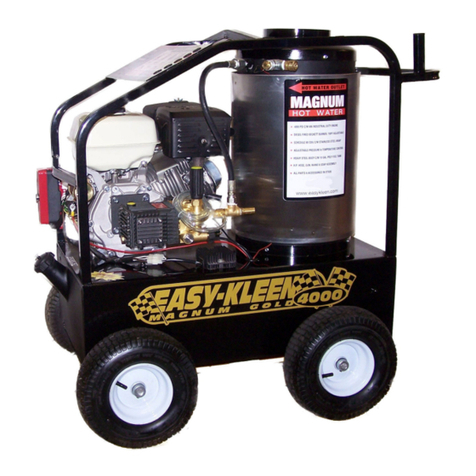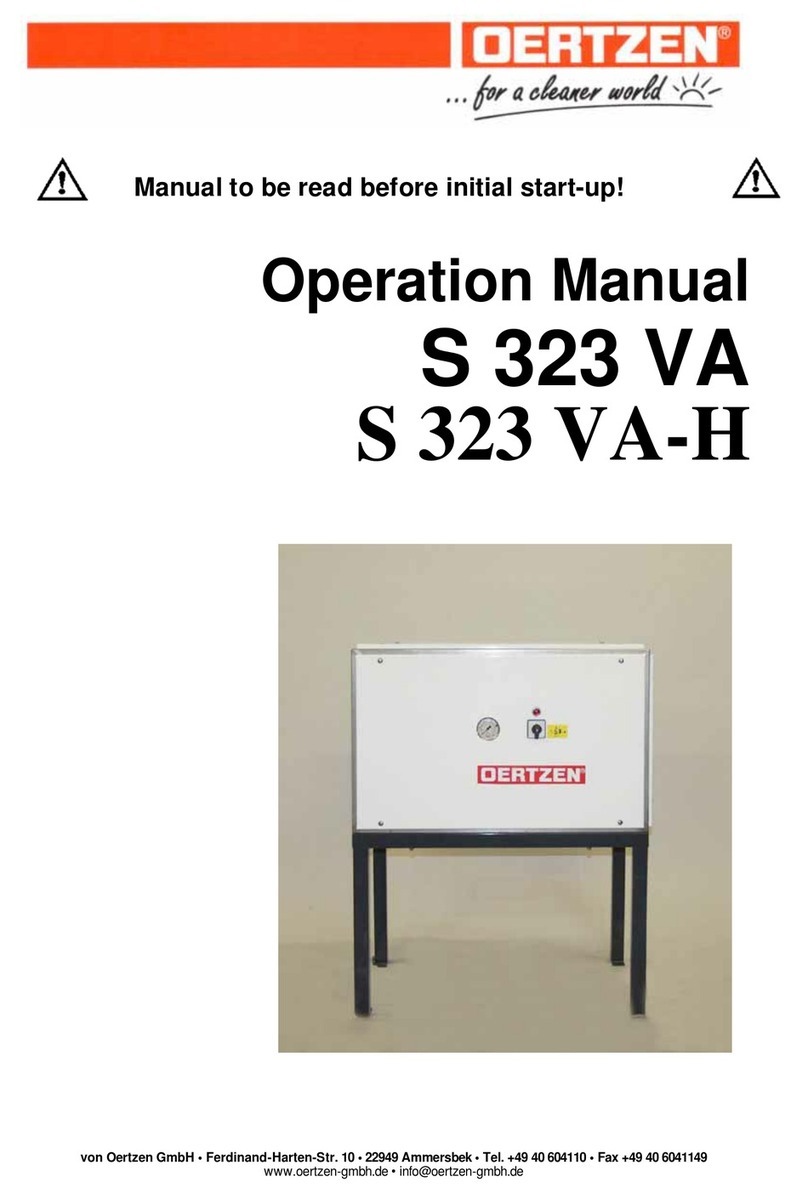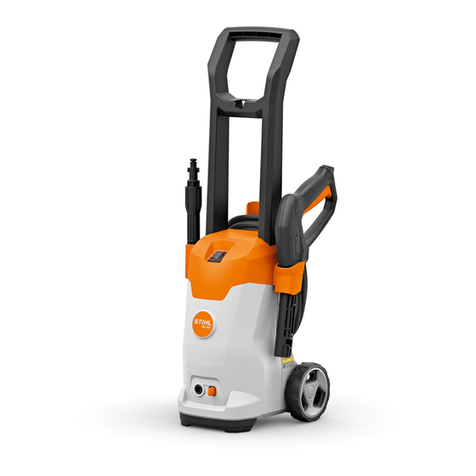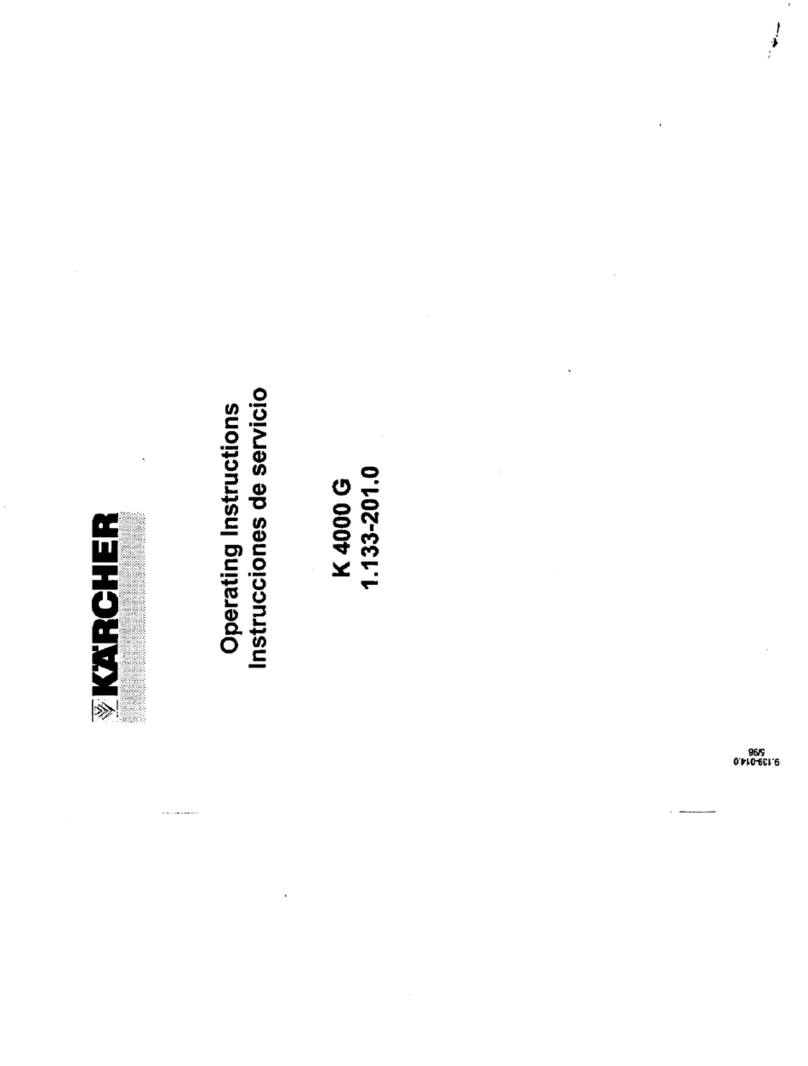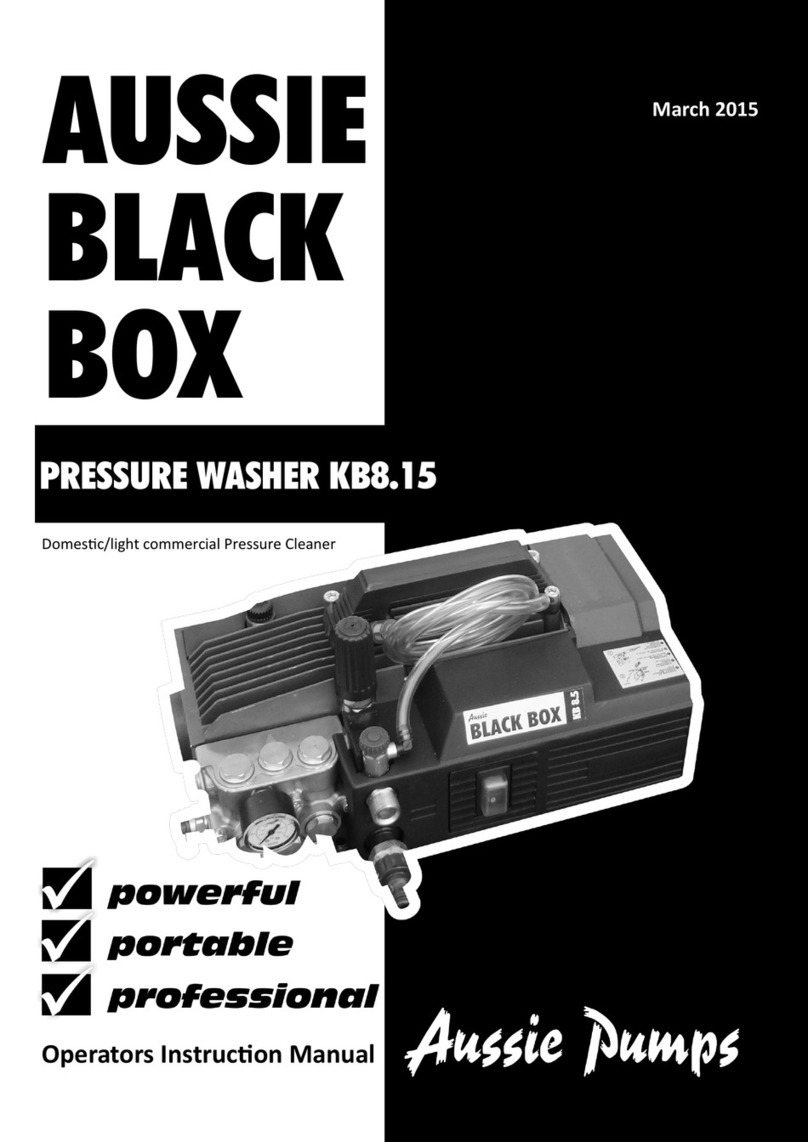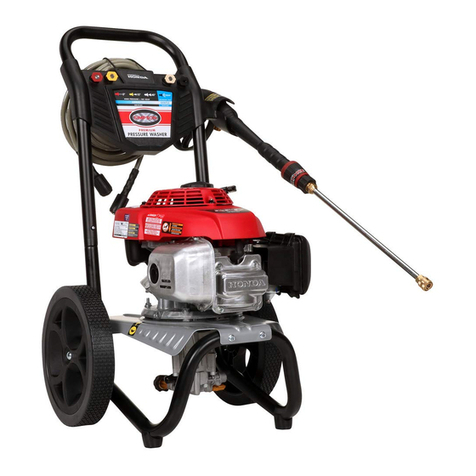Grainger 1TDJ2-1TDJ6 User manual

GP-SERIES Operator’s Manual 1
©Copyright 2005 Mi-T-M Corporation®Form #37-0996-E/S-101607
OPERATION MANUAL FOR
GP-SERIES
COLD WATER
DIRECT DRIVEN
PRESSURE WASHER
CAUTION
RISK OF INJURY!
READ MANUAL BEFORE OPERATING!
This manual is an important part of the
pressure washer and must remain with this unit!
MANUFACTURED FOR W.W. GRAINGER INC.
FOR CUSTOMER SERVICE CALL
1-800-648-8478
(GRAINGER ITEM #1TDJ2-1TDJ6)

2 GP-SERIES Operator’s Manual
TABLE OF CONTENTS
INTRODUCTION.............................................................................................................................3
IMPORTANT SAFETY WARNINGS.............................................................................................4-7
RISK OF EXPLOSION OR FIRE.....................................................................................................4
RISK OF ASPHYXIATION ...............................................................................................................5
RISK OF INJECTION OR SEVERE CUTTING INJURY .................................................................5
RISK OF ELECTROCUTION OR ELECTRICAL SHOCK ...............................................................5
RISK OF BURNS.............................................................................................................................6
RISK OF BURSTING.......................................................................................................................6
RISK FROM MOVING PARTS ........................................................................................................6
RISK OF BODILY INJURY ..............................................................................................................7
FEATURES ...............................................................................................................................8, 10
SAFETY DECALS..................................................................................................................... 9, 11
INSTALLATION & PREPARATION .........................................................................................12-15
ATTIRE ..........................................................................................................................................12
SET-UP..........................................................................................................................................12
ENGINE FUEL TANK ....................................................................................................................12
NOZZLE REVIEW .........................................................................................................................13
NOZZLE CONNECTION ...............................................................................................................13
WATER SUPPLY ........................................................................................................................... 14
UNLOADER...................................................................................................................................14
THERMAL RELIEF VALVE............................................................................................................14
PRE-START INSPECTION PROCEDURES .................................................................................15
OPERATING INSTRUCTIONS ................................................................................................16-17
PRIMING THE PUMP....................................................................................................................16
START-UP .....................................................................................................................................16
CLEANING WITH DETERGENTS ................................................................................................17
SHUTDOWN .................................................................................................................................17
STORAGE & MAINTENANCE.................................................................................................18-19
SPECIFIC MAINTENANCE ..........................................................................................................18
WINTERIZING...............................................................................................................................19
TROUBLESHOOTING..................................................................................................................20
STATEMENT OF WARRANTY .....................................................................................................21

GP-SERIES Operator’s Manual 3
INTRODUCTION
Congratulations on the purchase of your new GP-Series cold water pressure washer! You can be assured your pressure
washer was constructed with the highest level of precision and accuracy. Each component has been rigorously tested
by technicians to ensure the quality, endurance and performance of this unit.
This operator’s manual was compiled for your benet. By reading and following the simple safety, installation, operation,
maintenance and troubleshooting steps described in this manual, you will receive years of trouble free operation from
your new pressure washer. The contents of this manual are based on the latest product information available at the
time of publication. Mi-T-M® reserves the right to make changes in price, color, materials, equipment, specications or
models at any time without notice.
! IMPORTANT !
These paragraphs are surrounded by a “SAFETY ALERT BOX”. This box is used to designate
and emphasize Safety Warnings that must be followed when operating this pressure washer.
Accompanying the Safety Warnings are “signal words” which designate the degree or level
of hazard seriousness. The “signal words” used in this manual are as follows:
DANGER: Indicates an imminently hazardous situation which, if not avoided, WILL
result in death or serious injury.
WARNING: Indicates a potentially hazardous situation which, if not avoided, COULD
result in death or serious injury.
CAUTION: Indicates a potentially hazardous situation which, if not avoided MAY result
in minor or moderate injury.
The symbols set to the left of this paragraph are “Safety Alert Symbols”. These symbols
are used to call attention to items or procedures that could be dangerous to you or other
persons using this equipment.
ALWAYS PROVIDE A COPY OF THIS MANUAL TO ANYONE USING THIS EQUIPMENT. READ
ALL INSTRUCTIONS BEFORE OPERATING THIS PRESSURE WASHER AND ESPECIALLY
POINT OUT THE “SAFETY WARNINGS” TO PREVENT THE POSSIBILITY OF PERSONAL
INJURY TO THE OPERATOR.
Once the unit has been uncrated, immediately write in the serial number of your unit in the space provided below.
SERIAL NUMBER_________________________________
Inspect for signs of obvious or concealed freight damage. If damage does exist, le a claim with the transportation
company immediately. Be sure that all damaged parts are replaced and that the mechanical and electrical problems
are corrected prior to operation of the unit. If you require service, contact Customer Service at 800-648-8478.
Please have the following information available for all service calls:
1. Model Number
2. Serial Number
3. Date and Place of Purchase

4 GP-SERIES Operator’s Manual
POTENTIAL CONSEQUENCE PREVENTION
SAFETY WARNINGS
Warning: When using this product, precautions should always be observed, including the following.
READ ALL SAFETY WARNINGS BEFORE USING PRESSURE WASHER
RISK OF
EXPLOSION OR FIRE
Serious injury or death may occur
from normal sparks in the engine
ignition system or engine exhaust/
mufer.
HAZARD
Serious injury or death may occur
from a ground re caused by a
mufer spark.
Always operate pressure washer in a
well ventilated area free of ammable
vapors, combustible dust, gases or other
combustible materials.
Do not store the pressure washer near
an open ame or any equipment such as
a stove, furnace water heater, etc. which
utilizes a pilot light or sparking device.
Do not use this pressure washer to spray
ammable material!
Do not smoke while lling engine fuel tank.
Never ll the engine fuel tank while the
engine is running or hot. Allow the engine to
cool two minutes before refueling.
Do not refuel indoors or in a poorly
ventilated area.
Always refuel slowly to avoid the possibility
of spilled fuel which may cause a risk of re.
Refuel with gasoline only. Do not use diesel
or fuel oil.
Do not operate the unit if gasoline is spilled.
Wipe the pressure washer clean and move
it away from the spill. Avoid creating any
ignition until the gasoline has evaporated.
A spark arrester must be added to the
mufer of this engine if it is to be used
on any forest covered, brush covered
or grass covered unimproved land. The
arrester must be maintained in effective
working order by the operator. In the state
of California, the above is required by
law. (Section 4442 of the California Public
Resources Code.) Other states may have
similar laws. Federal laws apply on federal
lands.
Serious injury or death may occur
as a result of improper fueling.

GP-SERIES Operator’s Manual 5
POTENTIAL CONSEQUENCE PREVENTION
SAFETY WARNINGS
READ ALL SAFETY WARNINGS BEFORE USING PRESSURE WASHER
RISK OF
ASPHYXIATION
Serious injury or death may occur
from inhaling engine exhaust or
dangerous vapors. The engine
exhaust from this product contains
chemicals known to the State of
California to cause cancer, birth
defects, or other reproductive harm.
This pressure washer was designed for
outdoor use only. Never operate this pressure
washer in an enclosed area. Always make
certain there is adequate ventilation (fresh
outside air) for breathing and combustion.
This will prevent the buildup of dangerous
carbon monoxide gases. Beware of poorly
ventilated areas, or areas with exhaust fans
which can cause poor air exchange.
Follow all safety instructions provided with the
materials you are spraying. Use of a respirator
may be required when working with some
materials. Do not use this pressure washer
to dispense hazardous detergents.
RISK OF ELECTROCUTION
OR ELECTRICAL SHOCK
Serious injury or death may occur
from contact with electricity.
DO NOT direct spray on or into electrical
installationsof anykind! Thisincludeselectrical
outlets, light bulbs, fuse boxes, transformers,
the unit itself, etc.
DO NOT allow metal components of the
pressure washer to come in contact with live
electrical components.
Serious injury or death could
occur from high pressure spray
penetrating the skin.
Keep clear of nozzle and spray! Never put
your hand, ngers or body directly over the
spray nozzle.
Neverpoint the highpressure discharge spray
at yourself or anyone else.
Always keep operating area clear of all
persons.
DO NOT allow children to operate this unit.
SEEK EMERGENCY MEDICAL CARE if the
spray appears to have penetrated the skin!
DO NOT TREAT AS A SIMPLE CUT!!
High pressure hoses and fuel lines should be
inspected daily for signs of wear. If evidence
of failure exists, promptly replace all suspect
hosesandfuellinestopreventthepossibility of
injury from the high pressure spray. If a hose
or tting is leaking, NEVER PLACE YOUR
HAND DIRECTLY ON THE LEAK.
NEVER operate the gun with the trigger wired
in the open position. To prevent accidental
discharge, the trigger gun should be securely
locked when not in use.
Before removing the spray nozzle or servicing
the unit, ALWAYS shut off the unit and trigger
the gun to release trapped pressure. (Even
after youshutofftheunit,thereishighpressure
water left in the pump, hose and gun until you
release it by triggering the gun.
RISK OF INJECTION OR
SEVERE CUTTING INJURY
HAZARD

6 GP-SERIES Operator’s Manual
POTENTIAL CONSEQUENCE PREVENTION
SAFETY WARNINGS
READ ALL SAFETY WARNINGS BEFORE USING PRESSURE WASHER
RISK FROM MOVING PARTS Serious injury may occur to the
operator from moving parts on the
pressure washer.
RISK OF BURNS Serious injury could occur from
touching the engine mufer. This
area can remain hot for some
time after the pressure washer is
shutdown.
Serious injury may occur from a
pressure washer malfunction or
exploding accessories if incorrect
system components, attachments
or accessories are used.
Never allow any part of your body to
contact the engine mufer or adjacent
areas.
Never make adjustments to the factory set
pressures.
Never exceed manufacturers maximum
allowable pressure rating of attachments.
Do not allow any hoses to make contact
with the engine mufer or gasoline engine
to prevent the possibility of bursting. Avoid
dragging the hoses over abrasive surfaces
such as cement.
Use only manufacturer recommended repair
parts for your pressure washer.
In freezing temperatures, the unit must
always be warm enough to ensure there
is no ice formation in the pump. Do not
start the pressure washer if it has been
transported in an open or underheated
vehicle without rst allowing the pump to
thaw.
RISK OF BURSTING
Serious injury or death may occur
if attempting to start the pressure
washer when the pump is frozen.
Before making any adjustments, be certain
the engine is turned off and the ignition
cable(s) is removed from the spark plug(s).
Turning the machinery over by hand during
adjustment or cleaning might start the engine
and machinery with it.
Do not operate the unit without all protective
covers in place.
HAZARD

GP-SERIES Operator’s Manual 7
RISK OF BODILY INJURY
SAFETY WARNINGS
READ ALL SAFETY WARNINGS BEFORE USING PRESSURE WASHER
Serious injury or death may occur
from detergents contacting the
skin.
SEEKEMERGENCYMEDICALCAREifyouare
using cleaning agents and the spray appears
to have penetrated the skin! DO NOT TREAT
AS A SIMPLE CUT!! Be prepared to tell a
physician exactly what kind of detergents you
were using by reading the Material Safety Data
Sheet (MSDS) provided with your detergent.
Never use any solvents or highly corrosive
detergents or acid type cleaners with this
pressure washer.
Protective equipment such as rubber suits,
glovesand respiratorsare advisable, especially
when using cleaning detergents.
Keep all detergents out of the reach of
children!
ALWAYS wear protective goggles when
operating the unit to shield the eyes from ying
debris and detergents.
DO NOT direct spray toward fragile materials
such as glass for shattering could occur.
Stay alert-watch what you are doing. Do not
operate the unit when fatigued or under the
inuence of alcohol or drugs.
NEVER squeeze the trigger unless securely
braced.
DO NOT overreach or stand on unstable
support.
Wet surfaces can be slippery, wear protective
foot gear and keep good footing and balance
at all times.
NEVER trigger the gun while on a ladder or
roof.
ALWAYS hold on firmly to the gun/lance
assembly when starting and operating the unit.
Failure to do so can cause the lance to fall and
whip dangerously.
Know how to stop the pressure washer and
bleed pressures quickly. Be thoroughly familiar
with controls.
DO NOT leave pressurized unit unattended.
Shut off the pressure washer and release
trapped pressure before leaving.
DONOToperatetheunitifyouseeanyfuel,oilor
waterleaksfromthe machine. DONOTresume
operation until the unit has been inspected and
repaired by a qualied service person.
NEVER run the engine with the governor
disconnected or operate at excessive
speeds.
Place unit in a clean, dry, at area for servicing.
Beforeservicingtheunit,turntheunitoff,relieve
the water pressure from the trigger gun, and
allow the unit to cool down. Service in clean,
dry, at area. If applicable, block wheels to
prevent unit from moving.
Do not move the unit by pulling on the hose.
POTENTIAL CONSEQUENCE PREVENTION
!SAVE THESE INSTRUCTIONS!
Serious injury can occur from loose
debris being propelled at a high
speed from the spray gun.
Injury may occur if the operator
loses his balance caused by the
thrust of water traveling through the
spray nozzle.
Injury may occur from the
pressure washer.
HAZARD

8 GP-SERIES Operator’s Manual
FEATURES
FEATURES LISTING
1. Decal-Warning/Caution/Operating E/S 10. Water Outlet
2. Decal-Warning: Engine Fuel E/S 11. Water Inlet
3. Decal-Warning: Mufer Hot E/S 12. Detergent Hose
4. Engine 13. Water Inlet Strainer
5. Oil Fill 14. High Pressure Discharge Hose
6. Pump 15. Gun Assembly
7. Adjustable Unloader Knob 16. Wand
8. Thermal Relief Valve 17. Decal-Warning Risk of Injection E/S
9. Detergent Injector 18. Quick Connect Nozzle
GPFEATURE-072999-DCE

GP-SERIES Operator’s Manual 9
Reference #13 Decal: Caution-Engine Fuel (Part #34-0599)
Reference #14 Decal: Warning-Mufer Hot (Part #34-0598)
Location: On reference #18 Decal: Risk of Injection (Part #34-1253)
SAFETY DECALS
!!!DO NOT REmOvE sAFETy DECAls FROm UNIT
UNlEss REplACING WITh mOsT CURRENT sAFETy DECAl!!!
RISK OF BURNS
MUFFLER AND
ADJACENT AREAS
MAY EXCEED 150°F.
RIESGO DE QUEMAR
EL AMORTIGUADOR Y LAS
AREAS ADYACENTES PUEDEN
TENER TEMPERATURAS POR
ARRIBA DE 150°F.
34-0598-010699-E/S-ENG.
WARNING ADVERTENCIA
34-0599-E/S-030600-ENG
No ponga combustible cuando
el producto este en operacion.
Permita que el motor se enfrie
por 2 minutos antes de
reablastecer de combustible.
RISK OF FIRE
Do not add fuel when
product is operating. Allow
engine to cool for two (2)
minutes before refueling.
RIESGO DE FUEGE
CAUTION/PRECAUCION
Reference #15 Decal: Warning/Caution/Operating Statements (Part #34-1244)
• RISK OF INJECTION OR SEVERE INJURY. KEEP CLEAR OF
NOZZLE DO NOT DIRECT SPRAY TOWARD ANY PERSON OR
SELF.
• RISK OF ASPHYXIATION. OUTDOOR USE ONLY REQUIRED.
• RISK OF FIRE. DO NOT SMOKE WHILE REFUELING.ALLOW TO
COOL TWO TO THREE MINUTES BEFORE REFUELING. DO NOT
OPERATE WHILE REFUELING.
• RISK OF ELECTROCUTION. DO NOT DIRECT SPRAY TOWARD
ANY ELECTRICAL CONNECTIONS, OUTLETS, OR POWER LINES.
• RISK OF EXPLOSION. DO NOT SPRAY FLAMMABLE LIQUIDS.
• TO REDUCE RISK OF INJURY: READ AND UNDERSTAND THE
OPERATION MANUAL AND ALL INSTRUCTIONS BEFORE
USING.
• STAY ALERT: HOLD ONTO GUN/WAND FIRMLY WITH BOTH
HANDS TO AVOID DANGEROUS KICKBACKS.
• ALWAYS WEAR EYE PROTECTION.
• DO NOT OVERREACH OR STAND ON UNSTABLE SUPPORT.
KEEP GOOD FOOTING AND BALANCE AT ALL TIMES.
• ALWAYS TURN ON WATER SUPPLY TO PUMP BEFORE
STARTING.
• PROTECT PUMP FROM FREEZING.
• ENGAGE TRIGGER SAFETY LOCK-OFF WHEN NOT IN USE.
• AFTER ENSURING ALL CONNECTIONS ARE SECURE, OPEN INLET
WATER SUPPLY COMPLETELY. DO NOT OPERATEWITHOUTWATER.DO
NOT USE WATER THAT IS OVER 125˚F. • WITH GUN LOCKED, REMOVE
NOZZLE. POINT GUN IN A SAFE DIRECTION. BRACEWAND SECURELY
TO AVOID RECOIL.SQUEEZETRIGGER OPEN. STEADY THE UNIT AND
START BY PULLING ON THE STARTER ROPE. • AFTER ENGINE IS
RUNNING, LOCK GUN AND INSERT DESIRED NOZZLE. POINT GUN IN A
SAFE DIRECTION. UNLOCK GUN AND SQUEEZETRIGGER TO SPRAY
AND RELEASETHETRIGGERTO STOP SPRAY. • AFTER STOPPINGTHE
ENGINE, ALWAYSTURN OFFWATER SUPPLY AND SQUEEZETRIGGER
TO RELEASE TRAPPED PRESSURE.
• RIESGO DE INYECCION O LESION SEVERA. MANTENGA LA
BOUILLA DESPEJADA. NO DIRIJA EL CHORRO HACIA PERSONA
ALUNA O HACIA USTED.
• RIESGO DE ASFIXIA: UNICAMENTE PARA USO EN EL EXTERIOR.
• RIESGO DE FUEGO: NO FUME MIENTRAS ESTE
REABASTECIMIENTO DE COMBUSTIBLE. PERMITA QUE EL
MOTOR SE ENFRIE DOS O TRES MINUTOS ANTES DEL
REABASTECIMIENTO. NO OPERE EL PRODUCTOR DURANTE EL
REABASTECIMIENTO.
• RIESGO DE ELECTROCUCION: NO DIRECTA EL CHORRO HACIA
CONEXIONES. ELECTRICAS.TOMAS DE CORRIENTE O LINEAS
DE ALIMENTACION DE CORRIENTE.
• RIESGO DE EXPLOSION: NO ROCIE LIQUIDOS INFLAMMABLES.
• RIESGO DE LESION: USE UNICAMENTE EQUIP CON
CLASIFICACION ADEDUADA.
• PARA REDUCIR EL RIESGO DE QUE OCURRAN LESIONS:
LEA Y ENTIENDA EL MANUAL DE OPERACIONY TODAS LAS
INSTRUCCIONES ANTE DE USAR EL PRODUCTO.
• PERMANIZCA ALERTA: SOSTENGA LA PISTOLA VARILLA
FIRMENMENTE CON AMBAS MANO PARA EVITAR GOLPES
DE RETROCESO PELIGROSOS.
• USE SIEMPRE PROTECCION OCULAR.
• NO SE EXTIENDA DEMASIADO O SE PARE EN UN APOYO
INESTABLE. MANTENGA UNA BUENA POSICIONY
BALANCE TODO EL TIEMPO.
• ANTES DE COMENZAR. ABRA SIENPRE EL SUMINSTRO DE
AGUA A LA BOMBA.
• PROTEJA LA OMBA DE LA CONGELACION.
• COLOQUE EL SUGURO DEL GATILLO EN LA POSICION
APAGADO CUANDO NO ESTE USANDO EL PRODUCTO.
• DISPUES DE ASEGURARSE QUE TODAS LAS CONEXIONES
ESTAN SEGUIRSE.ABRA LA ENTRADA DEL SUMINSTRO DE AGUA
COMPLETAMENT NO SE OPERE SIN AGUA. NO SE USE CON AGUA
CONTEMPERATURAS DE MAS DE 125˚F.
• CON LA PISTOLA ASEGURADA. REMUEVA LA BOQUILLA
APUNTANDO LA PISTOLA HACIA UNA DIRECCION SEGURA.
REFURESE LAVARA PARA EVITAR QUE RETROCEDA.APRIETE EL
GATILLO PARA ABRIRLO.MANTEGA LA UNIDAD QUIETA.Y COMIENZE
HALANDO FIRMEMENTE EN LA CUERDA DE INICIAR.
• DESPUES DE QUE EL MOTOR ESTE TRABAJANDO.ADJUSTE LA
BOQUILLA A LA POSICION DESEADA.APRIETE EL GATILLO PARA
ROCIARY SUELTELO PARA DETENER EL ROCIADO.
•
DESPUES DE DETENER EL MOTOR. CIERRE DIEMPRE EL
SUMINSTRO DEL AGUO AND APRIETE EL GATILLO PARA LIBERAR
LA PRESION ATRAPADA.
WARNING/ADVERTENCIA CAUTION/PRECAUCION OPERATION/OPERACION
34-0981-063099-E/S-ENG.
RISK OF INJECTION OR SEVERE INJURY.
Never put your hand, fingers or body directly
over the spray nozzle.
34-1253-030801-ENG.
WARNING ADVERTENCIA
RIESGO DE INYECCION O LISION SEVERA
Nunca coloque la mano, los dedos o el cuerpo
directamente sobre la boquilla de rocío.

10 GP-SERIES Operator’s Manual
FEATURES
FEATURES LISTING
1. Decal-Warning/Caution/Operating E/S 10. Water Inlet
2. Decal-Warning: Engine Fuel E/S 11. Water Inlet Strainer
3. Engine 12. Detergen Hose with Strainer
4. Decal-Warning: Mufer Hot E/S 13. Water Outlet
5. Oil Fill 14. High Pressure Discharge Hose
6. Adjustable Unloader Knob 15. Gun Assembly
7. Pump 16. High Pressure Discharge Hose
8. Thermal Relief Valve 17. Wand
9. Detergent Injector 18. Quick Connect Nozzle
GP LG FEATURE-102599-RD

GP-SERIES Operator’s Manual 11
Reference #13 Decal: Caution-Engine Fuel (Part #34-0599)
Reference #14 Decal: Warning-Mufer Hot (Part #34-0598)
Location: On reference #18 Decal: Risk of Injection (Part #34-1253)
SAFETY DECALS
!!!DO NOT REmOvE sAFETy DECAls FROm UNIT
UNlEss REplACING WITh mOsT CURRENT sAFETy DECAl!!!
RISK OF BURNS
MUFFLER AND
ADJACENT AREAS
MAY EXCEED 150°F.
RIESGO DE QUEMAR
EL AMORTIGUADOR Y LAS
AREAS ADYACENTES PUEDEN
TENER TEMPERATURAS POR
ARRIBA DE 150°F.
34-0598-010699-E/S-ENG.
WARNING ADVERTENCIA
34-0599-E/S-030600-ENG
No ponga combustible cuando
el producto este en operacion.
Permita que el motor se enfrie
por 2 minutos antes de
reablastecer de combustible.
RISK OF FIRE
Do not add fuel when
product is operating. Allow
engine to cool for two (2)
minutes before refueling.
RIESGO DE FUEGE
CAUTION/PRECAUCION
• RISK OF INJECTION OR SEVERE INJURY. KEEP CLEAR OF
NOZZLE DO NOT DIRECT SPRAY TOWARD ANY PERSON OR
SELF.
• RISK OF ASPHYXIATION. OUTDOOR USE ONLY REQUIRED.
• RISK OF FIRE. DO NOT SMOKE WHILE REFUELING.ALLOW TO
COOL TWO TO THREE MINUTES BEFORE REFUELING. DO NOT
OPERATE WHILE REFUELING.
• RISK OF ELECTROCUTION. DO NOT DIRECT SPRAY TOWARD
ANY ELECTRICAL CONNECTIONS, OUTLETS, OR POWER LINES.
• RISK OF EXPLOSION. DO NOT SPRAY FLAMMABLE
LIQUIDS.
• TO REDUCE RISK OF INJURY: READ AND UNDERSTAND THE
OPERATION MANUAL AND ALL INSTRUCTIONS BEFORE
USING.
• STAY ALERT: HOLD ONTO GUN/WAND FIRMLY WITH BOTH
HANDS TO AVOID DANGEROUS KICKBACKS.
• ALWAYS WEAR EYE PROTECTION.
• DO NOT OVERREACH OR STAND ON UNSTABLE SUPPORT.
KEEP GOOD FOOTING AND BALANCE AT ALL TIMES.
• ALWAYS TURN ON WATER SUPPLY TO PUMP BEFORE
STARTING.
• PROTECT PUMP FROM FREEZING.
• ENGAGE TRIGGER SAFETY LOCK-OFF WHEN NOT IN USE.
• AFTER ENSURING ALL CONNECTIONS ARE SECURE, OPEN INLET
WATER SUPPLY COMPLETELY. DO NOT OPERATEWITHOUT WATER.DO
NOT USE WATER THAT IS OVER 125˚F. • WITH GUN LOCKED, REMOVE
NOZZLE. POINT GUN IN A SAFE DIRECTION. BRACEWAND SECURELY
TO AVOID RECOIL.SQUEEZETRIGGER OPEN. STEADY THE UNIT AND
START BY PULLING ON THE STARTER ROPE. • AFTER ENGINE IS
RUNNING, LOCK GUN AND INSERT DESIRED NOZZLE. POINT GUN IN A
SAFE DIRECTION. UNLOCK GUN AND SQUEEZE TRIGGER TO SPRAY
AND RELEASETHETRIGGERTO STOP SPRAY. • AFTER STOPPINGTHE
ENGINE, ALWAYSTURN OFFWATER SUPPLY AND SQUEEZETRIGGER
TO
RELEASE TRAPPED PRESSURE.
• RIESGO DE INYECCION O LESION SEVERA. MANTENGA LA
BOUILLA DESPEJADA. NO DIRIJA EL CHORRO HACIA PERSONA
ALUNA O HACIA USTED.
• RIESGO DE ASFIXIA: UNICAMENTE PARA USO EN EL EXTERIOR.
• RIESGO DE FUEGO: NO FUME MIENTRAS ESTE
REABASTECIMIENTO DE COMBUSTIBLE. PERMITA QUE EL
MOTOR SE ENFRIE DOS O TRES MINUTOS ANTES DEL
REABASTECIMIENTO. NO OPERE EL PRODUCTOR DURANTE EL
REABASTECIMIENTO.
• RIESGO DE ELECTROCUCION: NO DIRECTA EL CHORRO HACIA
CONEXIONES. ELECTRICAS.TOMAS DE CORRIENTE O LINEAS
DE ALIMENTACION DE CORRIENTE.
• RIESGO DE EXPLOSION: NO ROCIE LIQUIDOS INFLAMMABLES.
• RIESGO DE LESION: USE UNICAMENTE EQUIP CON
CLASIFICACION ADEDUADA.
• PARA REDUCIR EL RIESGO DE QUE OCURRAN LESIONS:
LEA Y ENTIENDA EL MANUAL DE OPERACIONY TODAS LAS
INSTRUCCIONES ANTE DE USAR EL PRODUCTO.
• PERMANIZCA ALERTA: SOSTENGA LA PISTOLA VARILLA
FIRMENMENTE CON AMBAS MANO PARA EVITAR GOLPES
DE RETROCESO PELIGROSOS.
• USE SIEMPRE PROTECCION OCULAR.
• NO SE EXTIENDA DEMASIADO O SE PARE EN UN APOYO
INESTABLE. MANTENGA UNA BUENA POSICIONY
BALANCE TODO EL TIEMPO.
• ANTES DE COMENZAR. ABRA SIENPRE EL SUMINSTRO DE
AGUA A LA BOMBA.
• PROTEJA LA OMBA DE LA CONGELACION.
• COLOQUE EL SUGURO DEL GATILLO EN LA POSICION
APAGADO CUANDO NO ESTE USANDO EL PRODUCTO.
• DISPUES DE ASEGURARSE QUE TODAS LAS CONEXIONES
ESTAN SEGUIRSE.ABRA LA ENTRADA DEL SUMINSTRO DE AGUA
COMPLETAMENT NO SE OPERE SIN AGUA. NO SE USE CON AGUA
CONTEMPERATURAS DE MAS DE 125˚F.
• CON LA PISTOLA ASEGURADA. REMUEVA LA BOQUILLA
APUNTANDO LA PISTOLA HACIA UNA DIRECCION SEGURA.
REFURESE LAVARA PARA EVITAR QUE RETROCEDA.APRIETE EL
GATILLO PARA ABRIRLO.MANTEGA LA UNIDAD QUIETA.Y COMIENZE
HALANDO FIRMEMENTE EN LA CUERDA DE INICIAR.
• DESPUES DE QUE EL MOTOR ESTETRABAJANDO. ADJUSTE LA
BOQUILLA A LA POSICION DESEADA.APRIETE EL GATILLO PARA
ROCIARY SUELTELO PARA DETENER EL ROCIADO.
•
DESPUES DE DETENER EL MOTOR. CIERRE DIEMPRE EL
SUMINSTRO DEL AGUO AND APRIETE EL GATILLO PARA LIBERAR
LA PRESION ATRAPADA.
WARNING/ADVERTENCIA CAUTION/PRECAUCION OPERATION/OPERACION
34-0981-063099-E/S-ENG.
Reference #15 Decal: Warning/Caution/Operating Statements (Part #34-1244)
RISK OF INJECTION OR SEVERE INJURY.
Never put your hand, fingers or body directly
over the spray nozzle.
34-1253-030801-ENG.
WARNING ADVERTENCIA
RIESGO DE INYECCION O LISION SEVERA
Nunca coloque la mano, los dedos o el cuerpo
directamente sobre la boquilla de rocío.

12 GP-SERIES Operator’s Manual
INSTALLATION & PREPARATION
ATTIRE:
Proper attire is essential to your safety. It is advised to utilize whatever means
necessary to protect eyes, ears, and skin. Additional safety attire (such as
respiratory mask) may be required when using detergent cleaning agents with
this washer.
SET-UP:
1. This unit should only be placed on a level surface to ensure proper lubrication
for the engine and water pump while operating.
2. Do not use unit in an area:
a. with insufcient ventilation.
b. where there is evidence of oil or gas leaks.
c. where ammable gas vapors may be present.
3. Do not allow the unit to be exposed to rain, snow or freezing temperatures.
If any part of the unit becomes frozen, excessive pressure may build up in
the unit which could cause it to burst resulting in possible serious injury to
the operator or bystanders.
4. Be certain to block the wheels to prevent the unit from moving while
operating.
5. Before initial use, ensure the oil cap/dipstick is inserted into the pump.
Because of varying shipping requirements, the pump may need to be shipped
with an oil travel plug instead of the dipstick in the pump. If your pump has
been shipped with an oil travel plug, you will need to remove it and replace
the plug with the oil dipstick provided with the unit.
6. Once properly installed, check the oil sight glass on the pump crankcase.
Be certain the oil level is in the center of the sight glass before each use. If
the level appears to be low, use SAE75W-90 for WP-2000 and WP-2400.
For all other WP-Series machines, use Mi-T-M®pump oil #AW-4085-0016.
DO NOT OVERFILL!
DANGER
RISK OF EXPLOSION OR FIRE!
DO NOT PLACE UNIT IN AN
AREA WHERE FLAMMABLE
GASVAPORSMAYBEPRESENT.
A SPARK COULD CAUSE AN
EXPLOSION OR FIRE!
RISK OF UNIT BURSTING!
DONOTSTORE/OPERATEUNITIN
A FREEZING ENVIRONMENT!
WARNING
RISK OF ASPHYXIATION!
-DO NOT OPERATE IN AN
ENCLOSED AREA. USE THIS
PRODUCT ONLY IN WELL
VENTILATED AREAS!
-THE EXHAUST FROM THE
ENGINE CONTAINS CARBON
MONOXIDE, A POISONOUS,
ODORLESS AND INVISIBLE
GAS. BREATHING THIS GAS
CAN CAUSE SERIOUS INJURY,
ILLNESS & POSSIBLE DEATH.
WARNING
RISK OF EXPLOSION OR FIRE!
ALWAYS STORE FUEL AWAY
FROM THE WASHER WHILE THE
UNIT IS RUNNING OR HOT.
DANGER
RISK OF FIRE!
-DO NOT S M O K E W H ILE
FUELING!
-DO NOT FILL THE FUEL TANK
WHILE UNIT IS RUNNING OR
HOT. ALLOW UNIT & ENGINE
TO COOL FOR TWO MINUTES
BEFORE REFUELING.
-DO NOT FILL FUEL TANK TO
POINT OF OVERFLOWING.
ALLOW APPROXIMATELY 1/4”
OF TANK SPACE FOR FUEL
EXPANSION.
ENGINE FUEL TANK:
1. Review “Risk of Explosion or Fire” pg. 4, before fueling.
2. Locate the Safety Decals on your unit and heed their warnings.
3. When lling fuel tank, a minimum of 86 octane fuel is recommended for use
with this unit. DO NOT MIX OIL WITH GASOLINE.
4. Purchase fuel in quantities that may be used within 30 days. Use of clean,
fresh lead free gasoline is recommended. Leaded gasoline may be used
if lead-free is unavailable. DO NOT use gasoline containing methanol or
alcohol.
5. Check the engine oil level before starting the engine. (See engine
manual.)
6. Fill fuel tanks according to the accompanying manufacturer’s instruction
manual. (See Engine manual.)
7. Refer to the engine manual supplied with this unit for proper adjustment
procedures.
8. Review the engine manual accompanying this pressure washer for
correct engine start-up and maintenance procedures.

GP-SERIES Operator’s Manual 13
INSTALLATION & PREPARATION
NOZZLE REVIEW:
Various nozzles may be quick-connected into the end of the wand to change
the spray pattern or use the detergent feature. When using Quick Connects
(Q.C.), be certain the connection is securely locked. If not, the high pressure
water may shoot the nozzle from the wand, causing severe injury or serious
damage. To determine spray fan, refer to the actual number stamped on the
nozzle. The rst two digits indicate the spray fan in degrees, i.e.; 15=15°,
25=25°, 65=detergent/low pressure.
1. The 15° nozzle (YELLOW): This is a chiseling nozzle. The spray should
be directed at a 45° angle to the surface and used like a scraper to remove
paint, grease and dirt. Uses: Surface preparation (removing mildew stains
and paint chips).
2. The 25° nozzle (GREEN): This is a ushing nozzle. This pattern is best
suited for ushing dirt, mud, and grime. Uses: Wet sweeping leaves from
walks, curbs and driveways, cleaning stable oors, washing swimming
pool bottoms, degreasing engines.
3. The 65° nozzle (BLACK): This is a low pressure detergent application
nozzle. This broad spray pattern distributes solution over vast areas under
low pressure. Uses: Detergent application, misting or rinsing.
QUICK-CONNECT (Q.C.)
WARNING
RISK OF INJECTION CAUSING
SEVERE INJURY!
NEVER LOOK DIRECTLY AT THE
NOZZLE ORIFICE UNLESS IT
IS DISCONNECTED FROM THE
GUN/WAND ASSEMBLY!
CONNECTION OF Q.C. NOZZLES
NOZZLE CONNECTION:
1. Be certain the trigger gun is locked in the “OFF” position. See WARNING,
right.
2. The nozzle assembly should be disconnected from the gun/wand assembly at
this time by retracting the locking ring on the quick-connect tting to remove
the nozzle.
WARNING
RISK OF SEVERE INJURY!
THE TRIGGER GUN SHOULD
ALWAYSBELOCKEDINTHEOFF
POSITION WHEN NOT IN USE!

14 GP-SERIES Operator’s Manual
WATER SUPPLY:
1. Select a water supply hose which is a quality grade of garden hose measuring
at least 3/4” ID and no longer than 50 feet.
2 Check the water inlet strainer to ensure it is clean and free of any obstructions.
As a strainer becomes obstructed, it restricts proper ow of water to the
pump. This can result in cavitations which will cause premature failure of
pump packings.
a. Using a screw driver, remove the screen from the water inlet.
b. Clean or replace with Mi-T-M #19-0001 if necessary.
3. Connect the hoses.
a. Connect one end of the water supply hose to the water inlet of the
unit.
b. Connect the other end of the hose to your pressurized water supply.
NOTE 1: Do not use a non-pressurized water supply (i.e. from a pond or well)
with this unit.
NOTE 2: When connecting the water inlet to the water supply mains, local
regulations of your water company must be observed. In some
areas, the unit must not be connected directly to the public drinking
water supply. This is to ensure there is no feedback of detergents
into the water supply. (Direct connection is permitted if a backow
preventer is installed. Check with local authorities for approval.)
c. Connect the high pressure discharge hose to the water outlet of the
unit.
d. Securely connect the other end of the hose to the gun assembly. (A
wrench may be required on some models.)
e. Connect the wand assembly to the gun/hose assembly.
4. Follow the incoming water requirements listed below:
a. Water pressure must be a minimum of 25 pounds per square inch (PSI)
and a maximum of 125 PSI. (A typical outdoor faucet will
generally supply this PSI if turned completely “ON”.)
b. Incoming GPM must be approximately one gallon more than the
outgoing GPM stated on the pressure washer nameplate. (You can
check GPM by timing how long it takes to ll a 5 gallon container.)
c. Incoming water temperature must not exceed 125°F. Excessive pump
damage may result if the water temperature exceeds this acceptable
level.
5. Never allow the unit to operate without the incoming water line attached and
the water supply completely turned on.
WATER INLET STRAINER
INSTALLATION & PREPARATION
UNLOADER:
The unloader is equipped with an adjustment knob to adjust the pressure. Should
less pressure be required, simply turn the adjustment knob counterclockwise.
To set back to maximum, turn adjustment knob completely clockwise. DO NOT
OVERTIGHTEN!
THERMAL RELIEF VALVE:
To ensure the water temperature does not exceed acceptable levels, never allow
the pressure washer to operate in the bypass mode (with the unit running and
the trigger gun closed) for more than three minutes.
A “Thermal Relief Valve” has been added to this unit to protect the pump. It
may begin to open and release water if the water temperature in the pump has
exceeded 140°F. This will allow fresh, cool water to enter the system.
CAUTION
RISK OF UNIT DAMAGE!
DO NOT OVERTIGHTEN THE
UNLOADER. BREAKAGECOULD
RESULT IN IMMEDIATE LOSS OF
WATER PRESSUREAND COSTLY
REPAIRS.

GP-SERIES Operator’s Manual 15
WARNING
THE FOLLOWING PAGES CONTAIN OPERATING
AND MAINTENANCE INSTRUCTIONS
DO NOT ATTEMPT TO OPERATE THIS
PRESSURE WASHER UNTIL YOU HAVE READ AND
UNDERSTOOD ALL SAFETY PRECAUTIONS AND
INSTRUCTIONS LISTED IN THIS MANUAL.
INCORRECT OPERATION OF THIS UNIT CAN CAUSE
SERIOUS INJURY!!
DO NOT ALTER OR MODIFY THIS EQUIPMENT IN ANY
MANNER!
PRE-START INSPECTION PROCEDURES:
Before starting the unit, perform the following procedures:
1. Check the oil level in the pump and engine.
2. Inspect the water inlet strainer. Clean or replace if necessary. See “Water
Supply”, #2, pg. 14.
3. Check all hose connections to ensure they are securely tightened. See
“Water Supply”, #3, pg. 14.
4. Inspect for system fuel leaks. If a fuel leak is found, DO NOT START UNIT!
See “Risk of Explosion or Fire”, pg. 4. Be sure that all damaged parts are
replaced and that the mechanical problems are corrected prior to operation
of the unit. If you require service, contact Customer Service.
5. Inspect high pressure hoses for kinking, cuts and leaks. If a cut or leak
is found, DO NOT USE HOSE! Replace hose before starting unit. See
“Risk of Injection” pg. 5. Be sure that all damaged parts are replaced and
that the mechanical problems are corrected prior to operation of the unit.
If you require service, contact Customer Service.
INSTALLATION & PREPARATION
END OF PREPARATION INSTRUCTIONS

16 GP-SERIES Operator’s Manual
OPERATING INSTRUCTIONS
PRIMING THE PUMP:
1. It is essential to prime the pump on initial start-up and each time the water
supply is disconnected from the unit after initial use.
2. Lay the high pressure hose out to remove any loops. Water ow will constrict
the hose, creating tight loops if the hose is not straight.
NOTE: The nozzle assembly should NOT be connected to the gun assembly
at this time. See “Nozzle Connection” pg. 13.
3. With the trigger gun locked in the “OFF” position, turn the water supply
completely on. Pointing the gun in a safe direction, unlock the trigger gun
and squeeze the trigger.
4. Low pressure water will begin owing from the hose/gun assembly. This
allows the unit to prime and purge any air from the system. The unit is
primed when water ow is uninterrupted by air.
5. Once the unit is primed, release the trigger and lock the gun in the “OFF”
position. Securely connect the nozzle assembly. (See “Nozzle Connection”
pg. 11.)
CAUTION
RISK OF DAMAGE.
DONOTALLOWSPRAYPATTERN
TO REMAIN ON A FIXED AREA
FOR AN EXTENDED PERIOD OF
TIME. POSSIBLE DAMAGE MAY
OCCUR TO THE AREA.
DANGER
RISK OF INJECTION CAUSING
SEVERE INJURY!
-KEEPCLEAROFNOZZLE!NEVER
PLACE HAND OR FINGERS IN
FRONT OF NOZZLE!
-DO NOT DIRECT DISCHARGE
STREAM AT PEOPLE OR PETS!
-BE CERTAIN THE NOZZLE
IS SECURELY CONNECTED
TO THE WAND TO PREVENT
ACCIDENTAL DISCHARGE!
START-UP:
1. Refer to the “Safety Precautions” pgs. 4-7 before starting the unit.
2. Locate the Safety Decals on your unit and heed their warnings.
3. Perform the following engine start-up procedures.
a. Point the trigger gun in a safe direction, disengage the safety lock on
the gun and squeeze the trigger.
b. Brace yourself for kickback from the high pressure created by the pump
once the engine has started.
c. Hold the trigger gun open while starting the engine according to the
manufacturer’s instructions in the engine manual accompanying this
unit.
4. Once the engine has started, perform the following procedures with the gun
open:
a. Inspect for system oil leaks and fuel leaks. If a fuel leak is found, TURN
UNIT OFF IMMEDIATELY! See “Risk of Explosion or Fire, pg. 4. Be sure
that all damaged parts are replaced and that the mechanical problems
are corrected prior to operation of the unit. If you require service, contact
Customer Service.
b. Inspect high pressure hoses for kinking, cuts and leaks. If a cut or
leak is found, DO NOT TOUCH HOSE AT LEAK!!! TURN UNIT OFF
IMMEDIATELY! Replace hose before restarting the unit. See “Risk of
Injection”, pg. 5. Be sure that all damaged parts are replaced and that
the mechanical problems are corrected prior to operation of the unit. If
you require service, contact Customer Service.
5. Trigger the gun several times. Be certain to LOCK the trigger gun in the
“OFF” position whenever changing the quick connect nozzles. NEVER
place hands or ngers in front of the nozzle or look directly into the nozzle!
High pressure water creates a risk of severe injury!
6. Do not allow unit to operate in bypass mode (with trigger closed) for more
than three minutes without triggering the gun. Failure to follow this simple
rule can cause premature failure of pump packings, resulting in costly pump
repair.
7. Your pressure washer can deliver high pressure spray and a variety of spray
patterns using cold water. If you wish to clean with detergents, see page
17 for the correct procedures.
CAUTION
RISK OF UNIT DAMAGE.
BE CERTAIN THE NOZZLE
ASSEMBLYISNOTCONNECTED
TO THE UNIT WHILE PRIMING
THE PUMP. PRIMING ALLOWS
MINERAL DEPOSITS TO BE
RELEASED FROM THE SYSTEM
WHICH WOULD OBSTRUCT
OR DAMAGE THE NOZZLE
ASSY. RESULTING IN COSTLY
REPAIRS.

GP-SERIES Operator’s Manual 17
OPERATING INSTRUCTIONS
CLEANING WITH DETERGENTS:
1. Prepare detergent solution according to label directions. Never pump
acids, alkaline, abrasive uids or solvents through the unit.
2. Some units are equipped with adjustable detergent knobs. Locate the
clear vinyl hose which leads to the pump head.
a. If your injector is equipped with an adjustment knob on the pump
head, you may adjust the amount of detergent desired by turning
the knob completely counterclockwise to set at the maximum siphon
rate.
b. If your injector is not equipped with an adjustment knob, the detergent
ratio is preset and cannot be adjusted.
3. Fully immerse the detergent strainer into the detergent solution.
4. With the trigger gun locked in the “OFF” position, securely quick-connect
the detergent spray nozzle (#6540° BLACK) into the end of the wand.
NOTE: This injection system is designed to apply detergents under low
pressure only. It will not allow detergent solutions to be introduced
into the system unless the detergent nozzle assembly installed in
the wand.
5. To apply solution; unlock the trigger gun and squeeze the trigger. In a
few moments a detergent/water mixture will exit the low pressure nozzle.
Start spraying the lower portion of the surface being cleaned and move
up, using long overlapping strokes. Applying from the bottom up helps
avoid streaking. Allow to soak briey. DO NOT allow detergent solution
to dry on the surface. (Avoid working on hot surfaces or in direct sunlight
to minimize the chances of the detergent drying, which may result in
damaging painted surfaces.) Be certain to rinse a small section at a
time.
6. To rinse; lock the trigger gun in the “OFF” position, securely quick-connect
the desired high pressure nozzle into the end of the wand. Unlock the
trigger gun and spray. It will take about 30 seconds to purge all detergent
from the line. For best rinsing results, start at the top and work down.
7. Siphon a gallon of water through the low pressure detergent injection
system after each use. This prevents the possibility of corrosion or
detergent residue causing mechanical problems during the next use.
QUICK CONNECT DETERGENT
SHUT-DOWN:
1. DO NOT close the choke to stop the engine. Backre or engine
damage may occur. Turn engine “OFF” as directed in the engine
manual.
2. Turn the water supply “OFF”.
3. Pointing the gun in a safe direction, trigger gun momentarily to relieve
any trapped pressure.
4. Disconnect and drain the nozzle assembly, gun, wand and hoses.
5. Store complete assembly in a safe, non-freezing area.

18 GP-SERIES Operator’s Manual
STORAGE & MAINTENANCE
ENGINE: The engine instructions that accompany your unit detail specic
procedures for maintenance of the engine. Following the engine
manufacturer’s recommendations will extend engine work life.
PUMP: The pump oil must be changed after the rst 25 hours of operation.
Once the initial oil change has been completed, it is recommended
the oil be changed every 3 months or 250 hour intervals. If oil
appears dirty or milky, changes may be required at a greater
frequency. Use Mi-T-M pump oil #AW-4085-0016. Fill only to the
center of the oil sight glass. DO NOT OVERFILL!
NOZZLES: Water ow through the spray nozzle will erode the orice, making
it larger, resulting in a pressure loss. Nozzles should be replaced
whenever pressure is less than 85% of the maximum. The frequency
of replacement will depend upon such variables as mineral content
in the water and number of hours the nozzle is used.
QUICK COUPLERS: There is an o-ring seal inside the female quick coupler.
This o-ring will deteriorate or, if the unit is allowed to pump
without the high pressure hose or nozzle attached, the o-ring may
be blown out occasionally. Simply insert a replacement o-ring to
correct the leak. (Additional o-rings can be purchased from your
dealer.)
LEAKS: Promptly eliminate any leaks found in the pumping system by
removing suspect parts, applying thread sealant to the threads
and reinstalling.
NOTE: If using teon tape, be certain no tape gets inside any plumbing to
prevent the possibility of a plugged spray nozzle.

GP-SERIES Operator’s Manual 19
STORAGE & MAINTENANCE
WARNING
RISK OF UNIT BURSTING!
DO NOT STORE/OPERATE UNIT
IN A FREEZING ENVIRONMENT!
WINTERIZING:
For storage and transportation purposes in subfreezing ambient temperatures,
it will be necessary to winterize this unit. This unit must be protected to the
lowest incurred temperature for the following reasons:
1. If any part of the pumping system becomes frozen; excessive pressure
may build up in the unit which could cause the unit to burst resulting in
possible serious injury to the operator or bystanders.
2. The pumping system in this unit may be permanently damaged if frozen.
FREEZE DAMAGE IS NOT COVERED BY WARRANTY.
If you must store your unit in an area where the temperature may fall below
32°F, you can protect your unit by following the procedure outlined below.
1. Gather the following items:
a. Two 5 gallon containers.
b. One gallon of antifreeze. (Use an environmentally safe
antifreeze.)
c. Water supply.
d. Three foot hose, 1/2-3/4 I.D. with a 3/4 inch male garden hose
tting.
2. Procedure:
a. To start winterizing, unit must be run and primed according to the
“Start-up” listed on page 16.
b. After running and priming, shut off the unit and water supply.
c. Relieve system pressure by pointing the trigger gun in a safe
direction and squeezing the trigger until water ow ceases to exit
the nozzle.
d. Lock the trigger gun in an OFF position and remove the nozzle.
e. In one 5 gallon container, mix the antifreeze and water according to
manufacturer’s recommendations for the temperature to which you
are winterizing.
NOTE: Proper winterizing is based on the recommended manufacturer’s
instructions listed on the “Protection Chart” shown on the back label
of most antifreeze containers.
f. Remove the water supply hose from the unit and attach the 3 foot
hose securely to the inlet connection. Submerge the other end into
the antifreeze solution.
g. Shut off the detergent injector if applicable.
h. Point the wand into the empty container and start the unit.
i. Trigger the gun until the antifreeze begins to exit the wand. Release
the trigger for 3 seconds, then trigger the gun for 3 seconds. Continue
cycling the gun several times until all the antifreeze mixture is
siphoned from the container.
j. Stop the unit.
k. Detach the 3 foot hose from the unit and drain any excess antifreeze
back into the 5 gallon container.
l. Disconnect the hose/gun/wand assembly from the unit and drain
any excess antifreeze back into the 5 gallon container.
m. Store the hose, gun and wand with the unit in a safe, non-freezing
area.
n. Store antifreeze solution for next use or dispose of according to state
EPA laws.
3. Optional Procedure:
a. Shut the unit and water supply off.
b. Relieve system pressure by pointing the trigger gun in a safe
direction and squeezing the trigger until water ow ceases to exit
the nozzle.
c. Disconnect and drain the hose, gun and wand.
d. Start the unit and allow it to run until all the water exits the unit. Once
the water has stopped owing from the unit, turn the unit off.
NOTE: When using this procedure, caution should be used as ice chips
can form from drops of water which could cause the unit to burst if
starting before completely thawed.
32˚F 0˚C

20 GP-SERIES Operator’s Manual
TROUBLESHOOTING
SYMPTOM PROBABLE CAUSE REMEDY
Engine will not start. Various engine problems. Refer to the engine manual
accompanying your unit.
Unit components are frozen. Allow to thaw. If any part of the unit
becomes frozen; excessive
pressure may build up in the unit
which could cause the unit to burst
resulting in possible serious injury to
the operator or bystanders.
No discharge at nozzle when Inadequate water supply. Ensure hose is 3/4” diameter and
trigger mechanism is squeezed. incoming water supply is turned on.
Kink in water inlet hose. Remove kink.
Low or uctuating pressure.
Kink in high pressure discharge hose. Replace hose.
Water inlet screen obstructed. Remove screen, clean or replace.
Pump sucking air. (Prime eliminated) Tighten all water intake connections
Eliminate leaks in intake line.
Not in high pressure mode. Insert a high pressure nozzle.
Obstructed or worn spray nozzle. Remove, clean or replace.
Damaged or obstructed valve assy. Remove, inspect, clean or replace.
on pump.
Pump packings worn. Replace packings.
Unloader/Bypass valve not operating
correctly. Repair or replace.
Water is leaking from the “Heat Water temperature is too high. Do not allow the unit to operate in
Dump Valve” the bypass mode (with trigger gun
closed) for more than 3 minutes.
Defective valve. Replace.
Oil appears milky or foamy. Water in oil. Change pump oil. Fill to proper
level.
Oil leaking from unit. Worn seals or o-rings Contact Mi-T-M Customer Service.
Detergent will not siphon into Detergent strainer is not completely Check, submerge if necessary.
Low Pressure Detergent mode. submerged in detergent solution.
Detergent strainer obstructed. Inspect, clean or replace.
Detergent hose cut, obstructed or Inspect, clean or replace.
kinked.
Detergent adjusting knob on pump Open adjusting knob. Refer to
turned to closed position. (If applicable.) “Cleaning with Detergents” pg. 17.
Not in low pressure mode. Insert 6540° (BLACK) nozzle.
Nozzle assembly is plugged. Clean or replace.
Too many high pressure hose Use one extension maximum.
extensions attached to the water outlet.
Ball & Spring in Venturi stuck. Remove, clean or replace.
Water ows back into detergent Ball & Spring in Venturi reversed, Remove, clean or replace.
container. missing or corroded.
Water ows from the nozzle when the Trigger gun is malfunctioning. Repair or replace.
trigger gun is locked in the “OFF”
position.
This manual suits for next models
2
Table of contents
Languages:
Popular Pressure Washer manuals by other brands
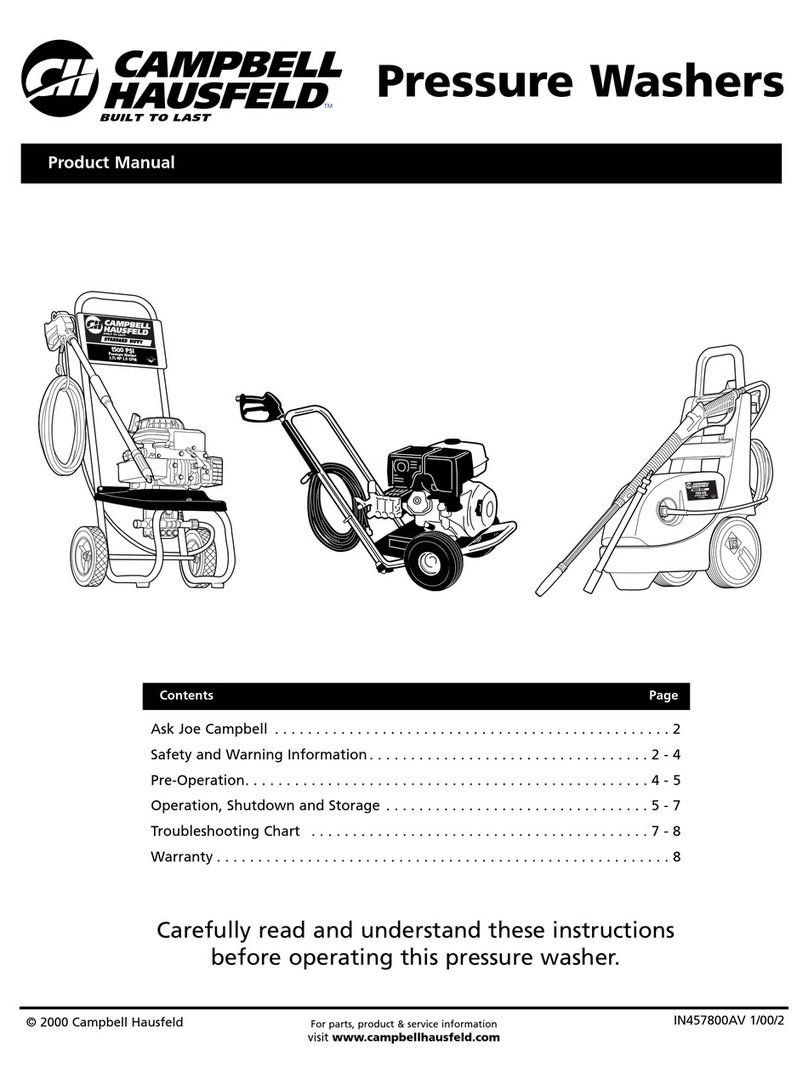
Campbell Hausfeld
Campbell Hausfeld Electric Pressure Washers product manual

Kärcher
Kärcher HDS 3.5/23-4M Eg manual

Pope
Pope 101HPW1800 Operator's manual

Dibo
Dibo ECN-M 110/13 Original instruction manual

Shark
Shark CB-3010 Operating instructions and parts manual

Craftsman
Craftsman 559.741710 owner's manual
